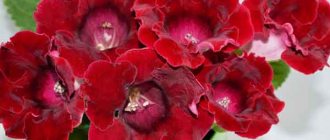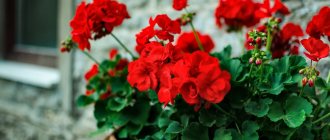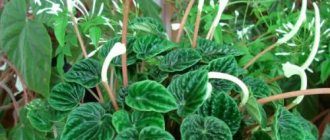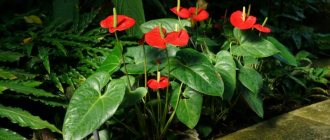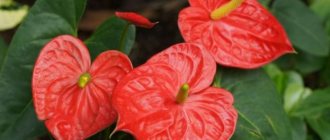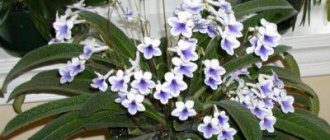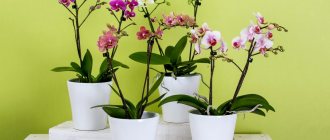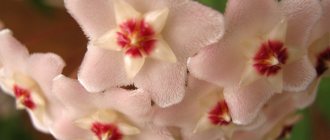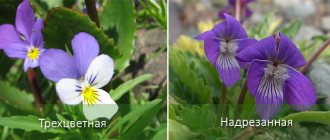It’s probably no secret that the Phalaenopsis Orchid is currently the most common orchid in indoor floriculture. Flower shops, window sills of apartments and houses, even the hands of caring men buying flowers for their beloved - literally everything indicates that the Phalaenopsis Orchid is the main choice of buyers. What is the reason for such popularity? Let's name the main ones: 1. Amazing view of the flower; 2. Easy to care for; 3. Long flowering period.
Since the popularity of Phalaenopsis is only growing every day, we considered it necessary to prepare for you a short description of the plant, describing all its advantages and disadvantages, as well as talking about its main conditions of maintenance and reproduction.
What kind of plant is this?
What kind of orchid is this magnificent phalaenopsis?
The name phalaenopsis unites not one, but several varieties of orchids, bred specifically for home cultivation. All of them are unpretentious and feel great in modern homes.
Phalaenopsis belongs to the Orchidaceae family . In nature, these flowers grow either in the form of herbaceous bushes on trees, or in lithophytic herbaceous groups on the surface of the earth.
Habitat: Philippines, northeastern Australia, southeast Asia, Pacific Islands. Orchids prefer a height of 200-400 meters above sea level, rocks in the depths of tropical rainforests, trunks and crowns of trees.
Favorable environment
The tropics , where phalaenopsis grows in nature, are the most favorable zone for its life.
The conditions created by nature, the important components of which will be the length of daylight hours, temperature, humidity, are the best possible way to promote its normal growth .
The bole can be located on a tree , but it is not a parasite.
Under natural conditions, the orchid is adapted to survive in the tropics without soil.
Phalaenopsis uses the trunk or branches of trees as a support ; this location helps the plant to absorb everything it needs with its roots as much as possible.
Orchids can also live on rocks ; placement on rocks is also possible.
The main thing is that there is enough moisture there.
Typically, such species use several roots as fasteners , tightly entwining the stone. The rest of the rhizome feeds the trunk.
In this article you will see a photo of a phalaenopis orchid in nature in the most favorable conditions, blooming. Read the history of the origin, how the orchid grows and reproduces in natural conditions, its varieties.
In nature, all orchid roots are aerial.
In nature, orchids obtain moisture from the air using aerial roots.
This is how orchids grow in the wild.
Under natural conditions, an orchid consumes a sufficient amount of moisture.
Orchids naturally grow on trees and rocky slopes.
Detailed description
Phalaenopsis have monopodial branching and grow in one direction .
The stem is short and thin. The leaves are leathery, dense, wide. They have an oblong-oval shape, located opposite in rosettes. Their width ranges from 5 to 10 cm, their length can reach 50 cm (in nature) and 30 cm (in culture). Evergreen, often have a marbled pattern. An adult plant usually has 5-6 of them. The roots are aerial with a thick layer of velamen and grow from the axils between the leaves. Condenses and absorbs dew and rainwater. Peduncles are long, arched, bearing 15-20 flowers. The flowers are large, 5-10 cm in diameter.
The color is rich, the color palette is varied: the petals can be either single-colored (pink, white, red, lilac, yellow, lilac) or variegated (with spots, stripes, specks). The bouquet lasts up to 4 months . The flower “lip” stands out in contrast against the background of the petals. Phalaenopsis can bloom at any time and up to 3 times a year. The size of an orchid ranges from 30 cm (miniature) to 1 meter (regular).
Why are these flowers called a miracle?
The color of the petals of this plant is so original and varied that in Europe they began to be called “a miracle of nature.” This comparison is correct. After all, to create such shades of flowers in the laboratory, you need to make a lot of effort, and these plants initially have such beautiful inflorescences. Also, this name is due to the fact that in most species the clusters grow downwards, hanging from the trees . This is rare in nature.
Orchids are found in almost every corner of the globe. They have adapted to life on almost all continents. The main criterion for their existence is high humidity and temperature. There are many varieties of this plant that have their own distinctive properties.
History of origin
The first mentions of this culture contain Chinese chronicles compiled 2500 BC, and the first flower was found in the distant 18th century by a traveler from Germany Georg Rimpfius , traveling through the Moluccas.
But the plant appeared in the first botanical reference book only in 1752, when another German naturalist, Carl Linnaeus, came into possession of a herbarium containing several carefully dried specimens of an outlandish flower. He gave it the first name Epidendrum amabilis - “living on a tree.”
Almost seven decades later, Blume, director of the botanical garden of Leiden, discovered several more specimens in the Malay Archipelago, and gave them another name Phalaenopsis - from the Greek words “Phalania” (night butterfly) and “Opsis” (resemblance).
The plant appeared in European botanical gardens at the beginning of the 19th century . The price for each specimen reached sky-high heights, and only monarchs could afford to purchase phalaenopsis for their personal collections.
In the 20th century, scientist-enthusiasts Knudson and More, independently of each other, developed the first hybrid, which easily crossed with other orchids. Anyone could now breed the variety. Hundreds of books have been written where you can read everything about it - the beautiful phalaenopsis, how to grow it yourself at home, how to replant and propagate.
Reanimation of the butterfly orchid
Despite its demands on external conditions, it is difficult to destroy a flower. If you care for a Phalaenopsis flower for a long time and incorrectly, then the orchid at home will not grow or bloom, but it will remain alive for a very long time. You can often see plants without leaves and without roots, as well as with a rotten growing point, among inexperienced and careless gardeners.
Usually such specimens are thrown away, but they can be revived. The technology for resuscitating orchids is very simple. But this is a long process. Let's look at some common problems and their solutions.
How to grow leaves on phalaenopsis
Stumps with a good root system, but without leaves, are not uncommon among inexperienced gardeners. Usually the plant loses its leaves due to dryness, compacted substrate or lack of feeding. If the root system is in order and there is an intact growth point, then growing leaves is quite simple.
The stump is transplanted into a new substrate, and then placed in a greenhouse or covered with a plastic bag.
Water and fertilize it regularly, following all the rules of watering and fertilizing. The leaves won't grow back anytime soon. It may take 1-2 months or even more until the orchid begins to grow.
How to grow roots
But it often happens the other way around - the orchid leaves are in place and in good condition, but the roots are rotten or completely missing. They can rot if improperly watered or too dry.
If the plant has rotten roots, they must be removed.
They grow roots by turning the orchid over and placing its leaves in water. The depth of water should not exceed 2 cm. Within 1-2 months, young roots will form on the flower. They need to be increased to at least 3 pieces so that the plant can be planted in the substrate.
How long do they live at home? Is it possible to extend life?
If the owner strictly follows all the standards of care, waters it correctly and, of course, showers his flower with love, the phalaenopsis can live in the house for 7-8 years .
Science knows of long-lived orchids, whose age was more than two hundred years.
Read about how to find out the age of a phalaenopsis orchid and rejuvenate it here.
What is the difference from other types?
- Phalaenopsis does not have false bulbs (tuberidia).
- The substrate serves as a support, so you can use light soil.
- Blooms several times a year.
- Monopodial growth.
- The air needs more moisture.
- The flowers are always larger.
- The leaves are semicircular.
We talked in more detail about the difference between phalaenopsis and other orchids in this article.
Characteristics of subvarieties and photos with names
The genus includes approximately 70 species of phalaenopsis, and there are several times more hybrid forms . In the photo you can see what home flowers look like. The most popular for growing at home are:
Amabilis
Phalaenopsis Amabilis (fariyatny) is the most suitable for crossing, the progenitor of many orchids.
Schiller
It blooms over and over again and can do so for a long period.
Pink
A miniature species, phalaenopsis flowers reach 3 cm in diameter .
Horse
Blooms all year round, especially abundantly in spring and autumn.
Giant
The leaves can grow up to a meter in length. The orchid is loved by breeders and biologists and is suitable for breeding new varieties .
Staghorn
Yellow-golden color with brown specks. The peduncle has a comb-like outgrowth.
Stewart
It has a branching peduncle up to 80 cm long.
Luddemann
The flowers are purple-pink and open one by one.
Sandera
A very beautiful and rare variety with long drooping peduncles , which can bear up to 50 flowers.
Ambuanian
Grows in the shade, blooms in the summer months, produces several flower stalks at the same time.
Parisha
Another miniature variety: peduncle – 14 cm, leaves – 18 cm, flowers – 2 cm. It has a pleasant aroma.
Hieroglyphic
Lemon-yellow strokes are drawn on the white background of the petals . The flowers smell delicious.
Philadelphia
Hybrid of Stewart and Schiller varieties. The flowers are small, purple-pink, with a marble pattern on the leaves.
3. Phalaenopsis varieties
It is very difficult to describe all varieties of phalaenopsis - after all, there are a great many of them, let’s look at just a few.
3.1. Schiller's Phalaenopsis - Phalaenopsis schilleriana
A profusely blooming species with large, pink flowers on drooping stalks that have a rose scent. The homeland of the plant is the Philippines. It has become widespread due to its unpretentiousness and tolerance to low lighting levels. An excellent hanging plant, which during the flowering period will hang large branched flower stalks with a cascade of pink flowers over the edges of a hanging flowerpot.
3.2.Phalaenopsis Sogo - Phalaenopsis Sogo
A small, compact, large-flowered orchid with very bright colors of buds in all colors of the rainbow. Among this variety there are variegated plants with yellow longitudinal stripes on thick, fleshy leaves. The orchid's peduncles are strong, erect, and during the flowering period the plant emits a very pleasant aroma.
3.3. Phalaenopsis Liodoro - Phalaenopsis Liodoro
A miniature multi-flowered subspecies with bright, soft, green leaves and short, often drooping flower stalks. The flowers are very brightly colored - the edges of the petals have a yellow tint, and towards the center they are abundantly covered with small specks, merging into a solid pink or lilac tone.
3.4.Phalaenopsis Mini Mark
A very beautiful, small-flowered plant, reaching a height of only 10 - 15 cm. The leaves are dark green, relatively large, glossy, slightly bent along the central vein. The peduncles are tall and thin, bearing small flowers at the top with white oblong petals covered with red or pink specks - freckles. The lower lip is painted a bright orange shade.
3.5.Phalaenopsis Sakura - Phalaenopsis Lius Sakura
A delicate orchid with thick, dark green, fleshy leaves and vertical tall flower stalks. Large flowers reach a diameter of 8 cm and occupy most of the height of the peduncle. The rounded petals are painted in delicate pink tones and have slightly corrugated tips. The center is colored yellow or orange.
You might also be interested in:
Dendrobium
Miltonia
Cymbidium
Anthurium
Bloom
When and how?
Flowering most often occurs 2 times a year, sometimes 3 . The number of flowers on a peduncle varies from 3 to 40 pieces. Flowering duration is from 2 to 6 months.
Features of care before and after
For successful flowering, an orchid must create optimal conditions:
- place it on a south, west or east window;
- do not flood;
- fertilize 1-2 times a month;
- install additional lamps for lighting.
We invite you to watch a video on how to prolong the flowering of the Phalaenopsis orchid:
What to do if flowers don't appear?
If all of the above conditions have been met, but the orchid refuses to bloom, you can try to stimulate the process: take the plant to a glassed-in balcony from a warm room. The difference between night and day temperatures contributes to more intense and lush flowering .
If the owner overfeeds the plant, it begins to grow green mass rather than bloom. Therefore, you will need to abandon fertilizing for a while.
Prevention of various problems
The main prevention of various diseases of the Liodoro orchid is compliance with the basic rules of care.
also not recommended to place plants close to each other , as this leads to rapid proliferation of pests and infection of all plants.
Among the long-flowering varieties of orchids, Phalaenopsis Liodoro occupies a leading position. Another feature of this flower is the pleasant sweetish aroma emitted by the opened buds.
A prerequisite for a long and abundant flowering period is proper care and necessary maintenance conditions.
Step-by-step care instructions
Selecting a location
Suitable windows for placement are western and eastern. It can also be placed in the south, but shading with curtains, blinds or a screen must be organized.
Preparing the soil and pot for planting
The pot must be of a suitable size and with good ventilation . It can be made of plastic or glass, or you can use a wooden or wicker basket. The best option is a transparent container, which allows you to monitor the condition of the root system and gives it maximum access to light.
The substrate must consist of the following components:
perlite;- vermiculite;
- polystyrene;
- leaf soil;
- Pine cones;
- sphagnum;
- peat (lowland or highland);
- charcoal;
- coir;
- expanded clay;
- bark (preferably pine).
All components are thoroughly washed in the shower, steamed, dried and crushed. For drainage, use broken red brick and small crushed stone .
Polystyrene foam cannot be used - it swells during watering and can gradually push the roots out of the pot.
Temperature
Summer temperature should be 25-30 degrees, winter 20-25 degrees.
Humidity
Suitable air humidity is 50-70%. It is best to place the container with the flower on a tray with water and pebbles .
The roots of the orchid should not touch the water in the tray.
Lighting
If there is a lack of natural light in the winter months, additional illumination with lamps is needed - at least 12 hours.
Felanopsis has a tendency to turn towards the flow of light . To prevent the plant from losing its decorative appearance and falling out of the pot, it must be rotated 180 degrees periodically (once every 2 weeks). This should not be done during the budding period.
Watering
For irrigation, purified water at room temperature is used. Felanopsis is watered 2 times a week. The earthen ball should dry completely between waterings. You can't water at night!
Even on hot summer days, phalaenopsis should not be sprayed.
If drops of water get into the core and axils between the leaves, they can rot, and if on the leaves, this will lead to burns due to exposure to sunlight.
We invite you to watch a video on how to properly water a Phalaenopsis orchid:
Top dressing
The fertilizer must be a special water-soluble or complex mineral fertilizer . It is diluted in a proportion of 1 gram. per 1 liter of water and add after watering. From October to March there is no need to feed.
Transfer
Replanting is carried out every three years to replace the substrate, as well as in cases where:
the roots have become pale or rotten;- the roots have grown so much that the flower no longer fits in the pot;
- when the children have grown up and the orchid needs to be divided.
The roots of an orchid are fragile and easy to damage, so replanting must be done carefully. They are soaked in warm water with potassium permanganate, dry and rotten areas are cut off, and the cut areas are disinfected with crushed activated carbon, cinnamon or garlic solution. You can soak the roots in the Fitosporin solution for 30-40 minutes .
We invite you to watch a video on how to properly replant Phalaenopsis:
You can find more information about caring for phalaenopsis here.
Landing
Orchids are often sold in transparent pots, through the walls of which you can see the roots. They should be greenish-silver (young) or with a yellowish tint (old). After purchase, the plant needs to be replanted.
Imported plants are usually supplied in soft “disposable” pots and a moisture-absorbing substrate that can be washed with a stream of warm water. To separate the roots from the walls, you need to lightly knead the pot with your hands.
As a new substrate when growing phalaenopsis in an apartment, it is best to use a mixture of boiled and dried pine bark and charcoal (10:1). In warm apartments, pebbles can be used as drainage, which will also ensure the stability of the pot. In other cases, the drainage may be pieces of bark 2-3 cm in size.
New roots appear only in the upper part of the stem, so the plants need to be planted so that 2-3 cm remains to the top edge of the pot and the substrate can be topped up as new roots appear and the lower leaves die off.
If a flowering plant was purchased in autumn or winter, it is better to remove the peduncle so that the flower does not deplete over the winter.
In the first year of life after transplantation, especially if a large substrate was used, it is useful to cover the surface of the roots with sphagnum moss. When the roots have entwined the substrate well, the moss is removed.
The most practical containers for growing are soft, thin-walled plastic pots. You can also use plastic mesh pots with additional holes in the bottom, which accommodate slightly larger pots.
How to breed?
It can only be propagated from a three-year-old plant. It should have a well-developed root system and 5 healthy leaves.
Plant propagation methods:
- seeds;
- children;
- sockets.
Do not allow the substrate to dry out or expose the seedlings to direct sunlight. Fertilizing with nitrogen fertilizer is necessary 2 times a month.
We invite you to watch a video about the methods and techniques of propagation of Phalaenopsis.
1 way:
Method 2:
Diseases and pests
Most often, the orchid is affected by non-infectious diseases . Exposure to sunlight causes burns on the leaves. Yellow spots appear if the flower is in a cold place or is poorly lit. Unreasonable watering leads to plant rotting. If an orchid has dropped its leaves, it means that the flower has been standing for a long time in a draft or under a stream of air from an air conditioner.
Viral diseases that occur in orchids:
- anthracnose;
- powdery mildew;
- rust;
- black fungus;
- rot.
Treatment is carried out by spraying with Ritomil, Mikasan, Skor . You can wash the plant in a solution of foundation or vitriol.
Pests:
- aphid;
- scale insect;
- worm.
First, the infected plant is washed under a warm shower (many pests die at temperatures above 40 degrees), then the pests are selected by hand and the orchid is treated with a 0.3% foundationazol, 0.2% benlate composition.
Several procedures are carried out with an interval of 2 weeks.
Some folk remedies help well: a solution of green soap, brewed onion and garlic peels.
We discussed in more detail issues related to diseases and pests of phalaenopsis, as well as ways to combat them, in this material.
Where and for how much can I buy it?
You can buy phalaenopsis in specialized flower shops and supermarkets.
The plant can also be purchased from gardening societies and clubs, at gardening exhibitions, from amateur gardeners and remotely. The best time to select a butterfly orchid is when it is in bloom .
Particular attention should be paid to the leaves: there should be no suspicious spots or signs of wilting on them. The roots of a healthy Phalaenopsis are strong and may protrude slightly.
The plant must sit firmly in the ground . If it wobbles, its root system is not viable and it is not worth buying such a specimen.
Price (price region - Moscow, St. Petersburg) - from 800 to several thousand rubles per copy.
